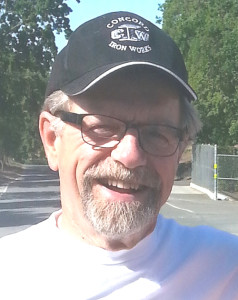1. Adolf Viggo Larsen (“Farr”) picked me up at the back door steps at 98 Castro Street, San Leandro in his 1936 LaSalle, 4-door family sedan everyday after work and we’d drive the remaining 50 feet or so to the barn-garage, beneath his homing pigeon loft above. What a thrill for a toddler, riding with Farr, 1945 or so. Dad was off in Germany fighting the remains of stupid Hitler’s failed and wasted quest for world domination.
2. Karen Marie Rasmussen, not yet a Larsen had left Denmark as a sixteen year-old, had come to Oakland and stayed with previously immigrated family aunts and uncles, worked for 6 years and then returned to Denmark and married that handsome former Danish Cavalryman, Adolf. Their quest was to come to America, study and acquire citizenship and “Save for the farm.” Later in the 1950s, on their 35-acre dairy farm in Orland, California, she (“Granmore”) would lead me by the hand, soft, working farmwoman’s hands, and show me how to gather eggs from under the sitting hens. “Not to worry, they may peck at you, but only take the real eggs, leave the glass eggs, if they have glass eggs to sit on, they’re more apt to lay eggs.” Granmore cooked like no one else, morning buttermilk waffles to die for, Danish Kringle, duck and pigeon dinners, “fit” and pumpernickle sandwiches with “ulle pulse,” a rolled lamb loaf, and “agaga salat,” her own pickled cucumbers! Wow!
3. Farr on the farm would also later show me how to make a temporary carburetor gasket for the LaSalle from shoebox cardboard. Not ideal, but they had survived the Depression, so they knew a certain magic of survival. “Place it over the flat manifold flange, and tap it along the edge with this ball-peen hammer. It will cut the outer shape and the inner shape also. Tap also the bolt holes the same way.” (I still have that hammer in my oldest toolbox. He let me keep it as a gift.) When Farr’s hay wagon had lost its forward hitch to the John Deere tractor due to age and wear, he made a new one from multiple strands of haywire he had down by the milking barn. Awesome, just awesome! From rusting, thrown-away mild steel wire, he made something durable at no cost, long before the world heard the words, “Recycle & Re-use.”
4. George Garfield Bray was born in Grass Valley, California, the son of a hard-rock miner from Cornwall, England and was a printer in a small shop in Oakland; he knew the warp and weave of paper and how the ink would absorb into it or “hold out” and lay on the surface of the paper. He would lift us, his grandkids to his lap and read to us “Black Sambo,” the book so often and well-read that the binding was totally shot, and the book was a collection of loose pages. One by one he’d turn them flawlessly and never lose the continuity of the story.
5. Ruth Edith Anderson Bray was in the kitchen, smells of her apple pie baking in the oven. It was always perfectly nearly white with just a touch of golden, baked crust highlights. Her Prime Rib Roast dinners were to write home about. Grammy was pretty unique in that for family parties she placed nametags at each place on the big table, and did we really have to eat that Tomato Aspic Salad? That stuff was horrid! Could we send them down to Mom, maybe she’d like them? And who were “Aunt Amy” and “Aunt Inger” and blind “Uncle Louie?” Members of their church or real relatives? Real Uncle Ed and Aunt Mary were awesome, Uncle Ed was hilariously funny and Aunt Mary worked at See’s Candies in Oakland and was a ceramicist in her basement studio in Oakland. At graduation from UC Berkeley in 1966 she made me a statuette of me as a graduate. Hand-painted and awesome! When I later visited Grammy as an adult, when it was just her and Uncle Paul, she’d note on her chalkboard in the breakfast nook, the date and that “Peter came to visit.” I guess that kept Uncle Paul informed, and he too was a Hoot, Dad’s older brother, who shot great slides of all his travels and lit my mind early about photography.
Peter Bray writes, lives, and works in Benicia and has written this column since 2008.







Leave a Reply